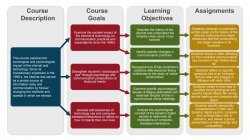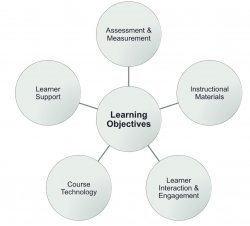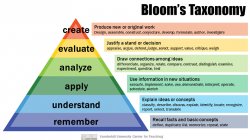The first question to ask yourself at the beginning of course design is what should my students know, value, or be able to do by the course’s end? Your answers to this question will influence everything- from how you organize your weekly content, to the readings you select, activities you conduct, and assessments you create.
You will transform these answers into course goals, measurable broad outcomes your students should achieve by taking your course. Your course goals will help you define learning objectives, which are more specific and measurable. Mastery of these will be demonstrated through your assessments.
Furthermore, here are some crucial questions for instructors:
- What do we expect our students to be able to do intellectually as a result of taking our courses?
- What kind of sustained and substantial difference can we make in the way they think, act, and even feel? If we spell out explicitly and systematically the learning objectives in our courses for ourselves and our students, the quality of teaching can be improved enormously.
- What do we want our students to be able to do intellectually (or sometimes physically or emotionally) as a result of our teaching?
Course Goals and Learning Objectives
Course Goal
What will my students be able to do by the end of the semester?
A Course Goal is a statement of the intended general outcomes of a program or course. Course goals are the larger ideas and essential questions connected to your field or discipline; they are often abstract and are not always easily assessed. They are what students should know, understand, believe, think, feel, or otherwise internally process as a result of course completion (Fink 2007; Wiggins & McTighe 2005; Linder 2017). One goal may have multiple learning objectives.
Course Goals are broad, general statements of what you students are expected to learn. They are often abstract and are not necessarily easily assessed. They are what students should know, understand, appreciate, and address the question, “What do I want my students to know or be able to do by the end of this course?” If your department has developed course goals for this course, use these to at least begin composing your course goals.
Learning Objective
What specific skills, knowledge or attitudes will students gain as a result of instruction?
A Learning Objective is a statement of what skills, knowledge, and attitudes (Dick & Carey, 1978) students will be able to do when they have completed a portion of your course, such as a unit of instruction or assignment. They should be student-centered, measurable and observable, and clearly stated so that students and instructors understand what is expected and will be measured; they may define the conditions under which performance or achievement of the objectives will be measured (Nilson 2010; Fink 2013; Wiggins & McTighe 2005; Linder 2017).
Learning Objectives are guides to the instructional decisions you make when designing and teaching your course. They help you select appropriate content, materials, instructional strategies, activities and assessments. All of these components should be consistent with the course goals. Strong learning objectives use action words, and many instructors find Bloom’s taxonomy helpful in creating learning objectives and assessment measures.
Example Course Blueprint
The diagram below illustrates an example of the alignment between course goals, learning objectives and learning outcomes for a course. Take a look at more details about this course and the assignments: The Sociology of Cyberspace

More About Learning Objectives
Characteristics of Effective Learning Objectives
A well-constructed learning objective usually includes three characteristics or components. (Mager 1984)
- Condition
- The Condition component of an objective is a description of circumstances under which the performance will be carried out.
- Performance
- The Performance component is a description of the behavior that learners are expected to perform. It should be measurable and observable. It describes what the learner will be doing when demonstrating mastery of an objective.
- Criterion
- The Criterion is a description of the criteria for acceptance of a performance as sufficient, indicating mastery of the objective. In other words, how well must it be done?
Example of a learning objective statement:“Given a set of data the students will be able to compute the standard deviation.”
This learning objective statement has the following components:
- Condition: When given a set of data
- Performance/Behavior: The student will be able to compute the standard deviation
- Criterion (implied): The number computed will be correct
Learning Objectives are Guides to:
- Selecting and developing instructional content/materials
- Using appropriate instructional strategies and technologies
- Identifying appropriate student support resources as needed
- Designing and facilitating active learning activities
- Constructing assignments, tests, and other instruments for assessing and evaluating student learning outcomes
Taxonomies of Learning to Aid Writing Learning Objectives
Taxonomies of learning are tools meant to aid in articulating course goals and learning objectives. Below we describe a commonly used taxonomy (Bloom’s Taxonomy) to guide course design decisions.
Bloom’s Taxonomy
Educators have given considerable thought to the various types of learning that occur in educational environments. In 1956, Benjamin Bloom developed what is commonly referred to as Bloom’s Taxonomy, illustrating the development of higher-order thinking skills. Using Bloom’s taxonomy enables instructors to design course modules with clear, measurable objectives. A group of cognitive psychologists, led by Lorin Anderson (a former student of Bloom), revised the taxonomy to fit 21st-century educational practices and published a new version in 2001.
There are multiple ways to approach designing courses. We have included a few other taxonomies, frameworks, and approaches to pedagogy in higher education:
- McTighe & Wiggins’ Six Facets of Understanding
- Dr. Fink’s Taxonomy of Significant Learning Outcomes
- bell hooks’ Teaching to Transgress
- Arend and Davis’ Seven Ways of Learning
- Anderson, L.W. (Ed.), Krathwohl, D.R. (Ed.), Airasian, P.W., Cruikshank, K.A., Mayer, R.E., Pintrich, P.R., Raths, J., & Wittrock, M.C. (2001). A taxonomy for learning, teaching, and assessing: A revision of Bloom’s Taxonomy of Educational Objectives (Complete edition). New York: Longman.
- Bloom, B.S. (Ed.), Engelhart, M.D., Furst, E.J., Hill, W.H., & Krathwohl, D.R. (1956). Taxonomy of educational objectives: The classification of educational goals. Handbook 1: Cognitive domain. New York: David McKay.
- Carnegie Mellon Eberly Center for Teaching Excellence and Educational Innovation. For additional information on writing course goals and learning objectives.
- Fink, L. D. (2003, 2013) Creating significant learning experiences. San Francisco, CA: Jossey Bass.
- hooks, . (1994). Teaching to transgress: Education as the practice of freedom.
- Linder, K., E. (2017). The blended course design workbook: a practical guide. Sterling, Virginia: Stylus
Publishing, LLC. - Wiggins, G. and McTighe, J. (2005) Understanding by Design, 2nd edition. Alexandria, VA: ASCD – (Association for Supervision and Curriculum Development)


